Business Environment Analysis Report: Coca-Cola Company Overview
VerifiedAdded on 2020/06/04
|15
|4627
|60
Report
AI Summary
This report provides a comprehensive analysis of the business environment, focusing on Coca-Cola as a case study. It begins with an introduction to the business environment and its impact on organizations. The report then delves into different types and purposes of organizations, differentiating between public, private, and voluntary sectors, and exploring their legal structures. It further examines the size and scope of various organizations, including micro, small, medium, and large scales, and their objectives. A key aspect of the report is the analysis of the relationships between different organizational functions, such as marketing and human resource management. Additionally, the report includes a PESTLE analysis to assess the positive and negative impacts of the macro environment on Coca-Cola. The report concludes with recommendations and a summary of the findings, providing insights into the complexities of the business environment and its influence on a global company like Coca-Cola.
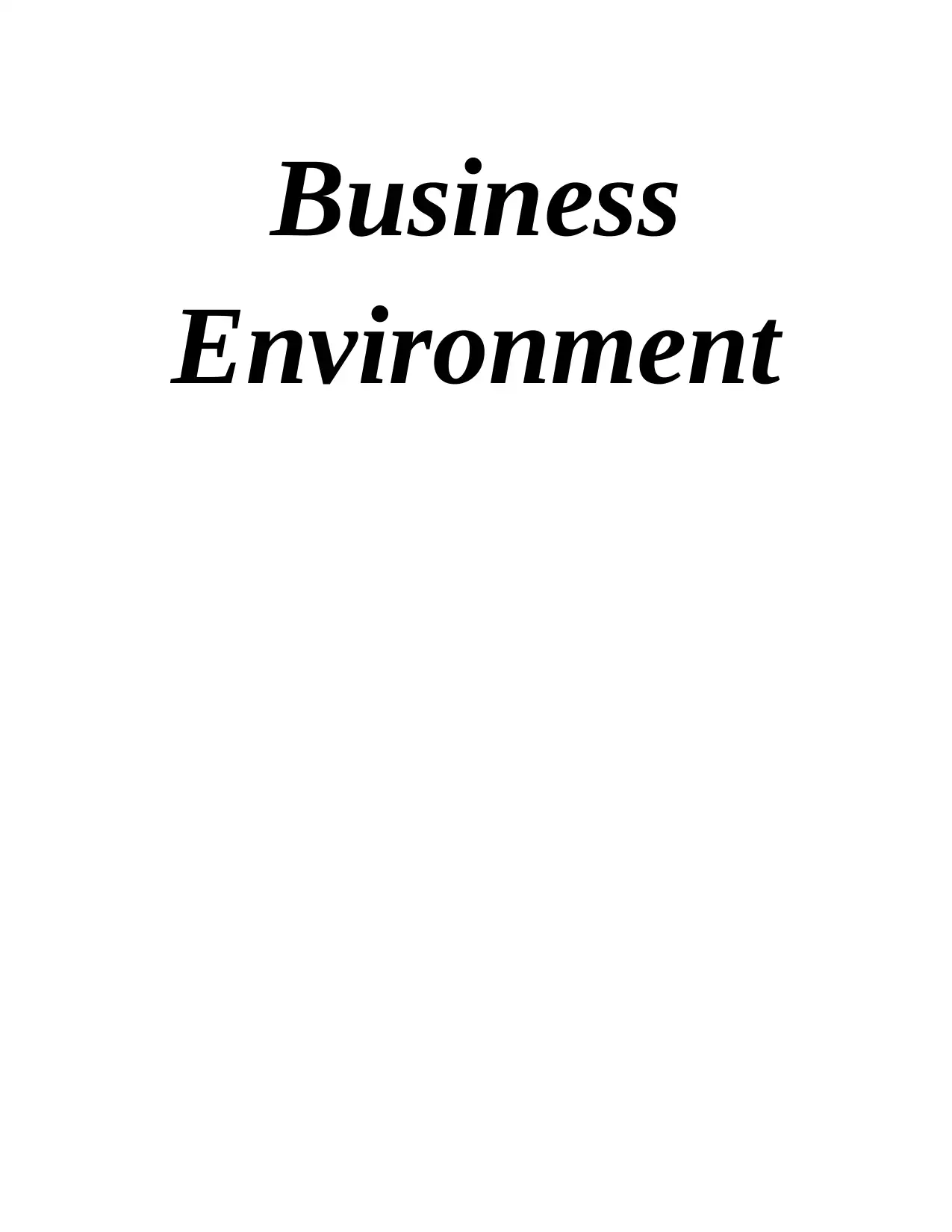
Business
Environment
Environment
Paraphrase This Document
Need a fresh take? Get an instant paraphrase of this document with our AI Paraphraser
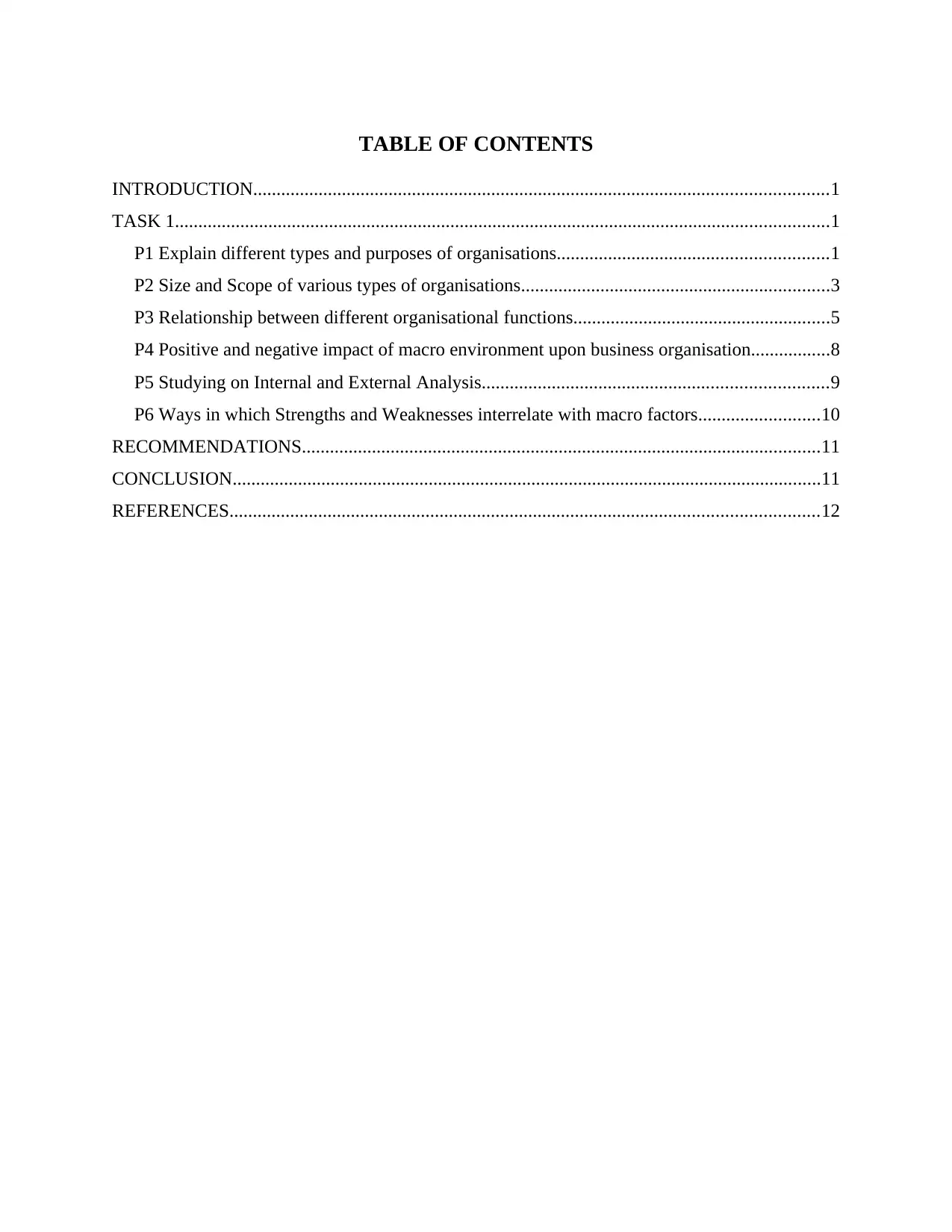
TABLE OF CONTENTS
INTRODUCTION...........................................................................................................................1
TASK 1............................................................................................................................................1
P1 Explain different types and purposes of organisations..........................................................1
P2 Size and Scope of various types of organisations..................................................................3
P3 Relationship between different organisational functions.......................................................5
P4 Positive and negative impact of macro environment upon business organisation.................8
P5 Studying on Internal and External Analysis..........................................................................9
P6 Ways in which Strengths and Weaknesses interrelate with macro factors..........................10
RECOMMENDATIONS...............................................................................................................11
CONCLUSION..............................................................................................................................11
REFERENCES..............................................................................................................................12
INTRODUCTION...........................................................................................................................1
TASK 1............................................................................................................................................1
P1 Explain different types and purposes of organisations..........................................................1
P2 Size and Scope of various types of organisations..................................................................3
P3 Relationship between different organisational functions.......................................................5
P4 Positive and negative impact of macro environment upon business organisation.................8
P5 Studying on Internal and External Analysis..........................................................................9
P6 Ways in which Strengths and Weaknesses interrelate with macro factors..........................10
RECOMMENDATIONS...............................................................................................................11
CONCLUSION..............................................................................................................................11
REFERENCES..............................................................................................................................12
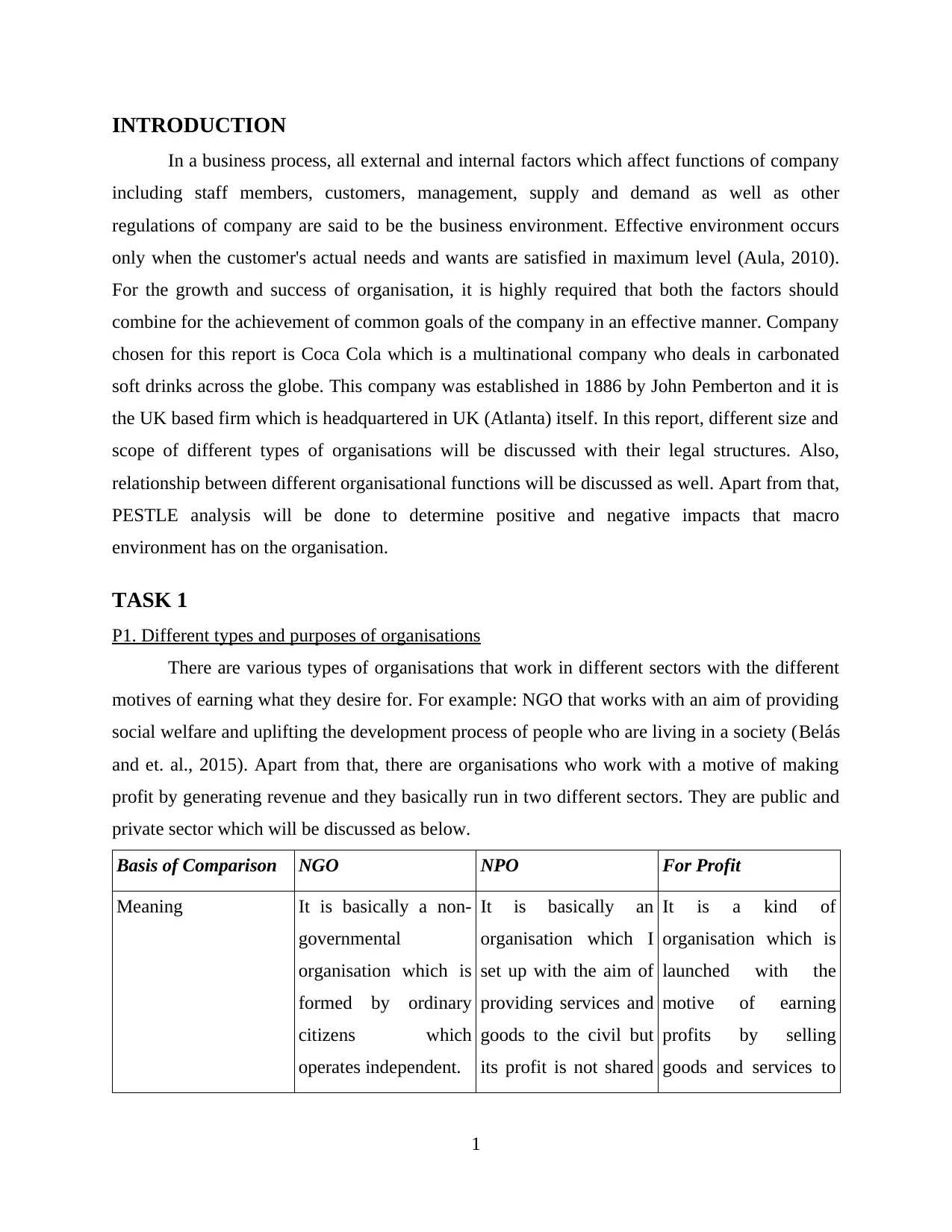
INTRODUCTION
In a business process, all external and internal factors which affect functions of company
including staff members, customers, management, supply and demand as well as other
regulations of company are said to be the business environment. Effective environment occurs
only when the customer's actual needs and wants are satisfied in maximum level (Aula, 2010).
For the growth and success of organisation, it is highly required that both the factors should
combine for the achievement of common goals of the company in an effective manner. Company
chosen for this report is Coca Cola which is a multinational company who deals in carbonated
soft drinks across the globe. This company was established in 1886 by John Pemberton and it is
the UK based firm which is headquartered in UK (Atlanta) itself. In this report, different size and
scope of different types of organisations will be discussed with their legal structures. Also,
relationship between different organisational functions will be discussed as well. Apart from that,
PESTLE analysis will be done to determine positive and negative impacts that macro
environment has on the organisation.
TASK 1
P1. Different types and purposes of organisations
There are various types of organisations that work in different sectors with the different
motives of earning what they desire for. For example: NGO that works with an aim of providing
social welfare and uplifting the development process of people who are living in a society (Belás
and et. al., 2015). Apart from that, there are organisations who work with a motive of making
profit by generating revenue and they basically run in two different sectors. They are public and
private sector which will be discussed as below.
Basis of Comparison NGO NPO For Profit
Meaning It is basically a non-
governmental
organisation which is
formed by ordinary
citizens which
operates independent.
It is basically an
organisation which I
set up with the aim of
providing services and
goods to the civil but
its profit is not shared
It is a kind of
organisation which is
launched with the
motive of earning
profits by selling
goods and services to
1
In a business process, all external and internal factors which affect functions of company
including staff members, customers, management, supply and demand as well as other
regulations of company are said to be the business environment. Effective environment occurs
only when the customer's actual needs and wants are satisfied in maximum level (Aula, 2010).
For the growth and success of organisation, it is highly required that both the factors should
combine for the achievement of common goals of the company in an effective manner. Company
chosen for this report is Coca Cola which is a multinational company who deals in carbonated
soft drinks across the globe. This company was established in 1886 by John Pemberton and it is
the UK based firm which is headquartered in UK (Atlanta) itself. In this report, different size and
scope of different types of organisations will be discussed with their legal structures. Also,
relationship between different organisational functions will be discussed as well. Apart from that,
PESTLE analysis will be done to determine positive and negative impacts that macro
environment has on the organisation.
TASK 1
P1. Different types and purposes of organisations
There are various types of organisations that work in different sectors with the different
motives of earning what they desire for. For example: NGO that works with an aim of providing
social welfare and uplifting the development process of people who are living in a society (Belás
and et. al., 2015). Apart from that, there are organisations who work with a motive of making
profit by generating revenue and they basically run in two different sectors. They are public and
private sector which will be discussed as below.
Basis of Comparison NGO NPO For Profit
Meaning It is basically a non-
governmental
organisation which is
formed by ordinary
citizens which
operates independent.
It is basically an
organisation which I
set up with the aim of
providing services and
goods to the civil but
its profit is not shared
It is a kind of
organisation which is
launched with the
motive of earning
profits by selling
goods and services to
1
⊘ This is a preview!⊘
Do you want full access?
Subscribe today to unlock all pages.

Trusted by 1+ million students worldwide
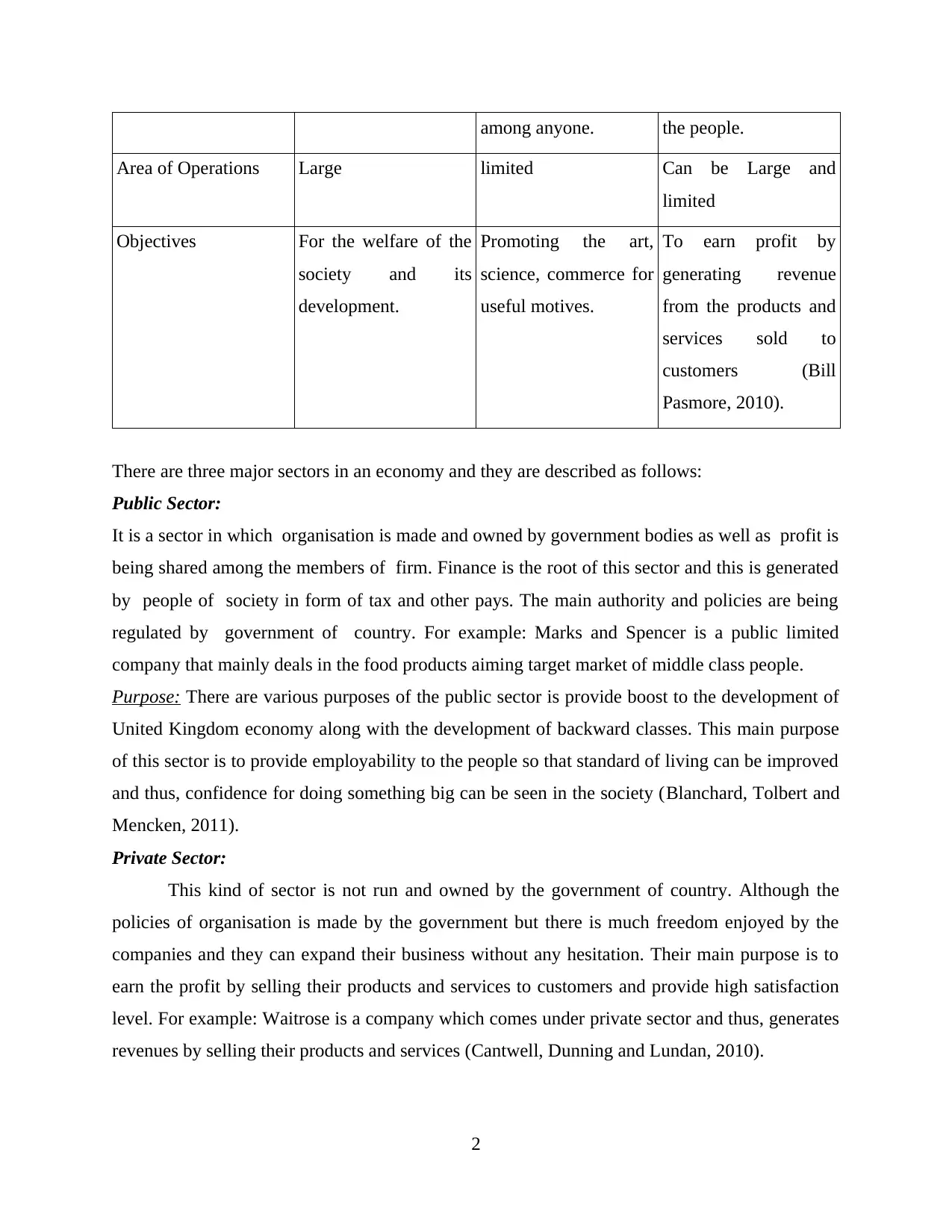
among anyone. the people.
Area of Operations Large limited Can be Large and
limited
Objectives For the welfare of the
society and its
development.
Promoting the art,
science, commerce for
useful motives.
To earn profit by
generating revenue
from the products and
services sold to
customers (Bill
Pasmore, 2010).
There are three major sectors in an economy and they are described as follows:
Public Sector:
It is a sector in which organisation is made and owned by government bodies as well as profit is
being shared among the members of firm. Finance is the root of this sector and this is generated
by people of society in form of tax and other pays. The main authority and policies are being
regulated by government of country. For example: Marks and Spencer is a public limited
company that mainly deals in the food products aiming target market of middle class people.
Purpose: There are various purposes of the public sector is provide boost to the development of
United Kingdom economy along with the development of backward classes. This main purpose
of this sector is to provide employability to the people so that standard of living can be improved
and thus, confidence for doing something big can be seen in the society (Blanchard, Tolbert and
Mencken, 2011).
Private Sector:
This kind of sector is not run and owned by the government of country. Although the
policies of organisation is made by the government but there is much freedom enjoyed by the
companies and they can expand their business without any hesitation. Their main purpose is to
earn the profit by selling their products and services to customers and provide high satisfaction
level. For example: Waitrose is a company which comes under private sector and thus, generates
revenues by selling their products and services (Cantwell, Dunning and Lundan, 2010).
2
Area of Operations Large limited Can be Large and
limited
Objectives For the welfare of the
society and its
development.
Promoting the art,
science, commerce for
useful motives.
To earn profit by
generating revenue
from the products and
services sold to
customers (Bill
Pasmore, 2010).
There are three major sectors in an economy and they are described as follows:
Public Sector:
It is a sector in which organisation is made and owned by government bodies as well as profit is
being shared among the members of firm. Finance is the root of this sector and this is generated
by people of society in form of tax and other pays. The main authority and policies are being
regulated by government of country. For example: Marks and Spencer is a public limited
company that mainly deals in the food products aiming target market of middle class people.
Purpose: There are various purposes of the public sector is provide boost to the development of
United Kingdom economy along with the development of backward classes. This main purpose
of this sector is to provide employability to the people so that standard of living can be improved
and thus, confidence for doing something big can be seen in the society (Blanchard, Tolbert and
Mencken, 2011).
Private Sector:
This kind of sector is not run and owned by the government of country. Although the
policies of organisation is made by the government but there is much freedom enjoyed by the
companies and they can expand their business without any hesitation. Their main purpose is to
earn the profit by selling their products and services to customers and provide high satisfaction
level. For example: Waitrose is a company which comes under private sector and thus, generates
revenues by selling their products and services (Cantwell, Dunning and Lundan, 2010).
2
Paraphrase This Document
Need a fresh take? Get an instant paraphrase of this document with our AI Paraphraser
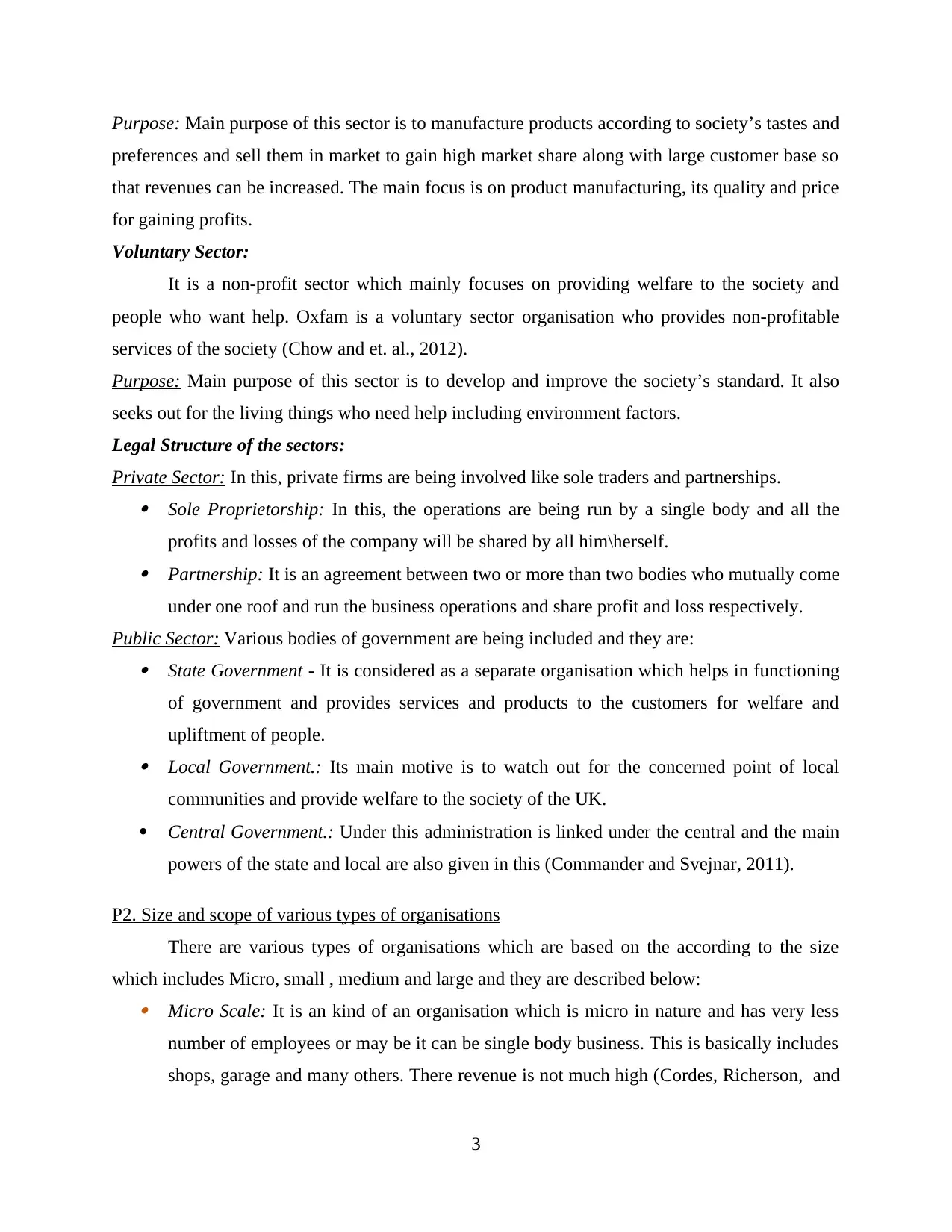
Purpose: Main purpose of this sector is to manufacture products according to society’s tastes and
preferences and sell them in market to gain high market share along with large customer base so
that revenues can be increased. The main focus is on product manufacturing, its quality and price
for gaining profits.
Voluntary Sector:
It is a non-profit sector which mainly focuses on providing welfare to the society and
people who want help. Oxfam is a voluntary sector organisation who provides non-profitable
services of the society (Chow and et. al., 2012).
Purpose: Main purpose of this sector is to develop and improve the society’s standard. It also
seeks out for the living things who need help including environment factors.
Legal Structure of the sectors:
Private Sector: In this, private firms are being involved like sole traders and partnerships. Sole Proprietorship: In this, the operations are being run by a single body and all the
profits and losses of the company will be shared by all him\herself. Partnership: It is an agreement between two or more than two bodies who mutually come
under one roof and run the business operations and share profit and loss respectively.
Public Sector: Various bodies of government are being included and they are: State Government - It is considered as a separate organisation which helps in functioning
of government and provides services and products to the customers for welfare and
upliftment of people. Local Government.: Its main motive is to watch out for the concerned point of local
communities and provide welfare to the society of the UK.
Central Government.: Under this administration is linked under the central and the main
powers of the state and local are also given in this (Commander and Svejnar, 2011).
P2. Size and scope of various types of organisations
There are various types of organisations which are based on the according to the size
which includes Micro, small , medium and large and they are described below: Micro Scale: It is an kind of an organisation which is micro in nature and has very less
number of employees or may be it can be single body business. This is basically includes
shops, garage and many others. There revenue is not much high (Cordes, Richerson, and
3
preferences and sell them in market to gain high market share along with large customer base so
that revenues can be increased. The main focus is on product manufacturing, its quality and price
for gaining profits.
Voluntary Sector:
It is a non-profit sector which mainly focuses on providing welfare to the society and
people who want help. Oxfam is a voluntary sector organisation who provides non-profitable
services of the society (Chow and et. al., 2012).
Purpose: Main purpose of this sector is to develop and improve the society’s standard. It also
seeks out for the living things who need help including environment factors.
Legal Structure of the sectors:
Private Sector: In this, private firms are being involved like sole traders and partnerships. Sole Proprietorship: In this, the operations are being run by a single body and all the
profits and losses of the company will be shared by all him\herself. Partnership: It is an agreement between two or more than two bodies who mutually come
under one roof and run the business operations and share profit and loss respectively.
Public Sector: Various bodies of government are being included and they are: State Government - It is considered as a separate organisation which helps in functioning
of government and provides services and products to the customers for welfare and
upliftment of people. Local Government.: Its main motive is to watch out for the concerned point of local
communities and provide welfare to the society of the UK.
Central Government.: Under this administration is linked under the central and the main
powers of the state and local are also given in this (Commander and Svejnar, 2011).
P2. Size and scope of various types of organisations
There are various types of organisations which are based on the according to the size
which includes Micro, small , medium and large and they are described below: Micro Scale: It is an kind of an organisation which is micro in nature and has very less
number of employees or may be it can be single body business. This is basically includes
shops, garage and many others. There revenue is not much high (Cordes, Richerson, and
3
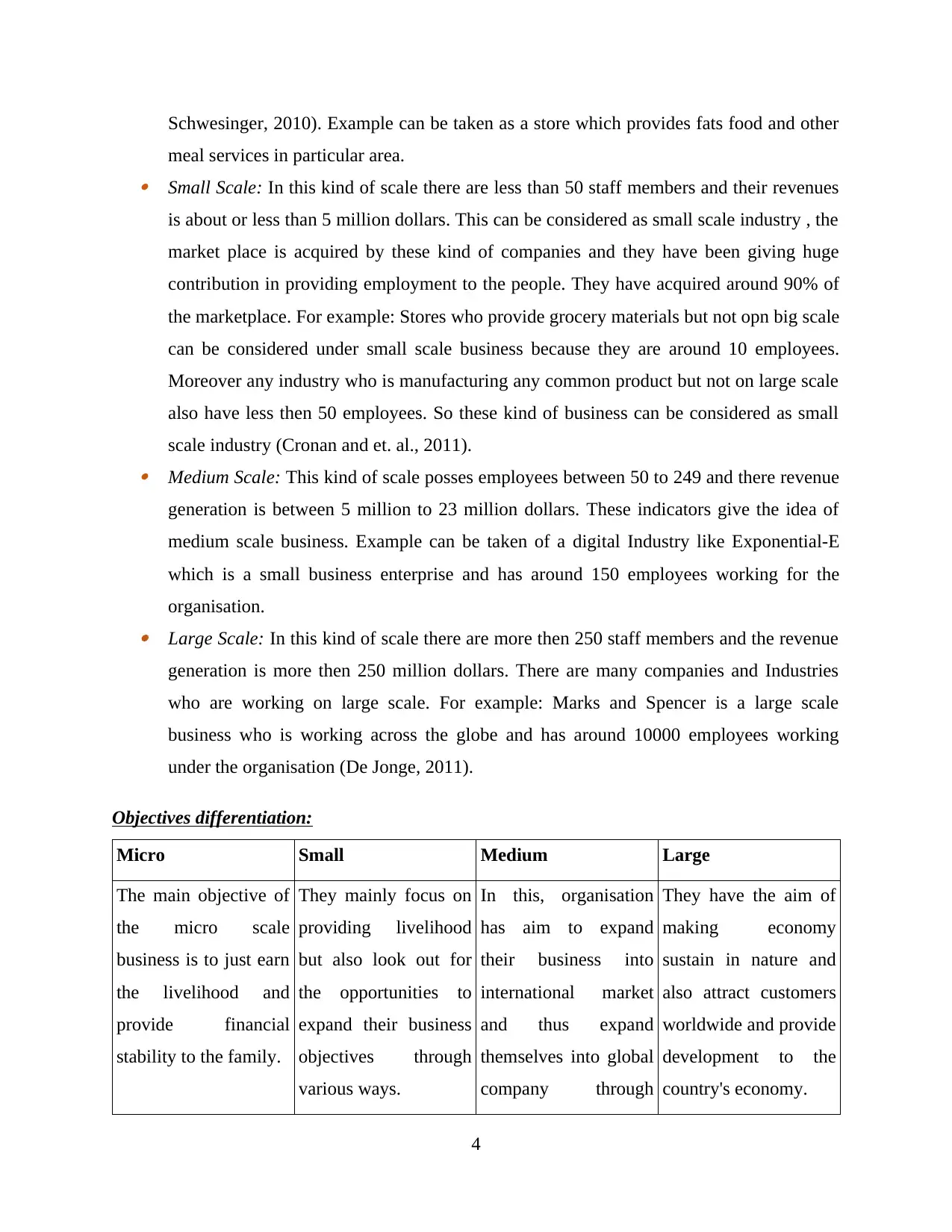
Schwesinger, 2010). Example can be taken as a store which provides fats food and other
meal services in particular area. Small Scale: In this kind of scale there are less than 50 staff members and their revenues
is about or less than 5 million dollars. This can be considered as small scale industry , the
market place is acquired by these kind of companies and they have been giving huge
contribution in providing employment to the people. They have acquired around 90% of
the marketplace. For example: Stores who provide grocery materials but not opn big scale
can be considered under small scale business because they are around 10 employees.
Moreover any industry who is manufacturing any common product but not on large scale
also have less then 50 employees. So these kind of business can be considered as small
scale industry (Cronan and et. al., 2011). Medium Scale: This kind of scale posses employees between 50 to 249 and there revenue
generation is between 5 million to 23 million dollars. These indicators give the idea of
medium scale business. Example can be taken of a digital Industry like Exponential-E
which is a small business enterprise and has around 150 employees working for the
organisation. Large Scale: In this kind of scale there are more then 250 staff members and the revenue
generation is more then 250 million dollars. There are many companies and Industries
who are working on large scale. For example: Marks and Spencer is a large scale
business who is working across the globe and has around 10000 employees working
under the organisation (De Jonge, 2011).
Objectives differentiation:
Micro Small Medium Large
The main objective of
the micro scale
business is to just earn
the livelihood and
provide financial
stability to the family.
They mainly focus on
providing livelihood
but also look out for
the opportunities to
expand their business
objectives through
various ways.
In this, organisation
has aim to expand
their business into
international market
and thus expand
themselves into global
company through
They have the aim of
making economy
sustain in nature and
also attract customers
worldwide and provide
development to the
country's economy.
4
meal services in particular area. Small Scale: In this kind of scale there are less than 50 staff members and their revenues
is about or less than 5 million dollars. This can be considered as small scale industry , the
market place is acquired by these kind of companies and they have been giving huge
contribution in providing employment to the people. They have acquired around 90% of
the marketplace. For example: Stores who provide grocery materials but not opn big scale
can be considered under small scale business because they are around 10 employees.
Moreover any industry who is manufacturing any common product but not on large scale
also have less then 50 employees. So these kind of business can be considered as small
scale industry (Cronan and et. al., 2011). Medium Scale: This kind of scale posses employees between 50 to 249 and there revenue
generation is between 5 million to 23 million dollars. These indicators give the idea of
medium scale business. Example can be taken of a digital Industry like Exponential-E
which is a small business enterprise and has around 150 employees working for the
organisation. Large Scale: In this kind of scale there are more then 250 staff members and the revenue
generation is more then 250 million dollars. There are many companies and Industries
who are working on large scale. For example: Marks and Spencer is a large scale
business who is working across the globe and has around 10000 employees working
under the organisation (De Jonge, 2011).
Objectives differentiation:
Micro Small Medium Large
The main objective of
the micro scale
business is to just earn
the livelihood and
provide financial
stability to the family.
They mainly focus on
providing livelihood
but also look out for
the opportunities to
expand their business
objectives through
various ways.
In this, organisation
has aim to expand
their business into
international market
and thus expand
themselves into global
company through
They have the aim of
making economy
sustain in nature and
also attract customers
worldwide and provide
development to the
country's economy.
4
⊘ This is a preview!⊘
Do you want full access?
Subscribe today to unlock all pages.

Trusted by 1+ million students worldwide
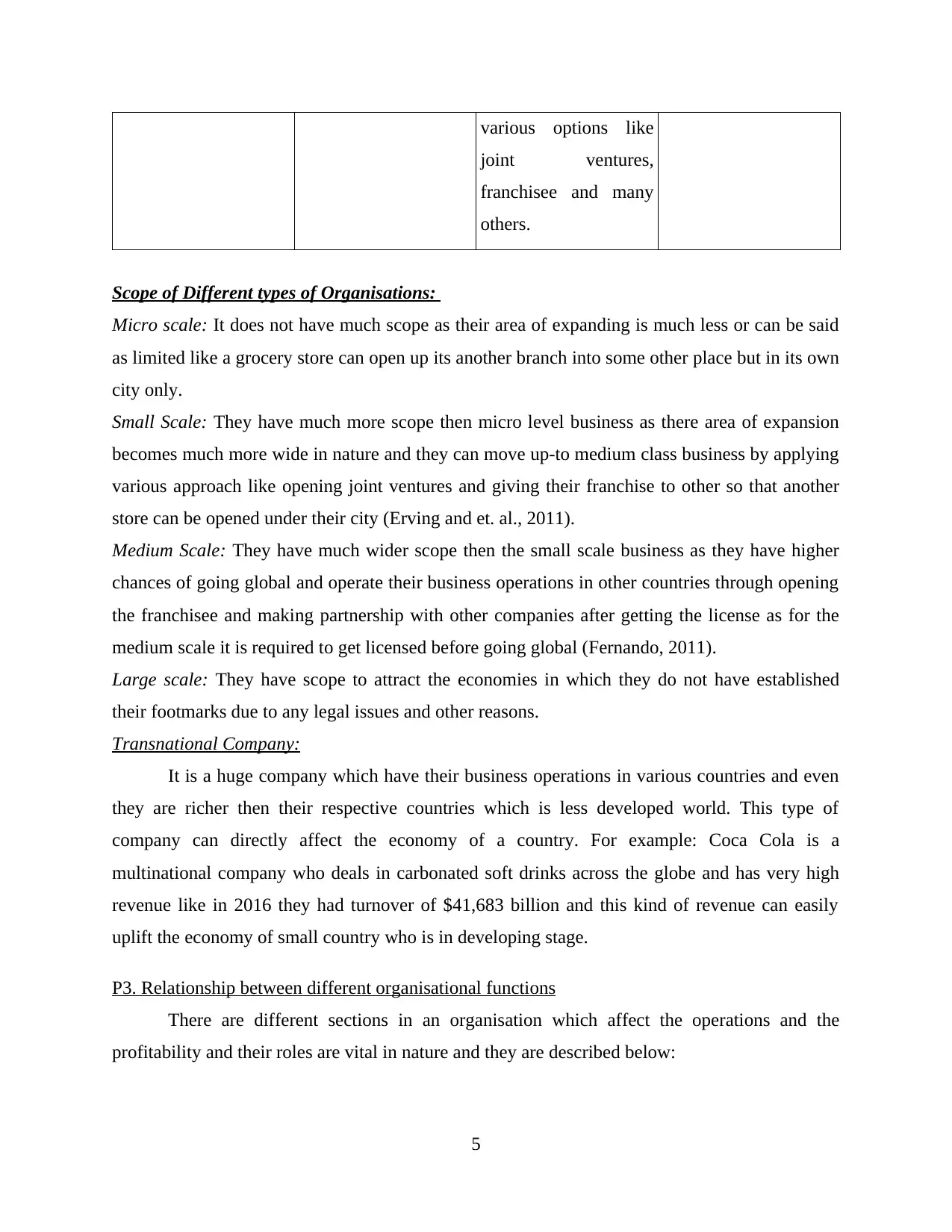
various options like
joint ventures,
franchisee and many
others.
Scope of Different types of Organisations:
Micro scale: It does not have much scope as their area of expanding is much less or can be said
as limited like a grocery store can open up its another branch into some other place but in its own
city only.
Small Scale: They have much more scope then micro level business as there area of expansion
becomes much more wide in nature and they can move up-to medium class business by applying
various approach like opening joint ventures and giving their franchise to other so that another
store can be opened under their city (Erving and et. al., 2011).
Medium Scale: They have much wider scope then the small scale business as they have higher
chances of going global and operate their business operations in other countries through opening
the franchisee and making partnership with other companies after getting the license as for the
medium scale it is required to get licensed before going global (Fernando, 2011).
Large scale: They have scope to attract the economies in which they do not have established
their footmarks due to any legal issues and other reasons.
Transnational Company:
It is a huge company which have their business operations in various countries and even
they are richer then their respective countries which is less developed world. This type of
company can directly affect the economy of a country. For example: Coca Cola is a
multinational company who deals in carbonated soft drinks across the globe and has very high
revenue like in 2016 they had turnover of $41,683 billion and this kind of revenue can easily
uplift the economy of small country who is in developing stage.
P3. Relationship between different organisational functions
There are different sections in an organisation which affect the operations and the
profitability and their roles are vital in nature and they are described below:
5
joint ventures,
franchisee and many
others.
Scope of Different types of Organisations:
Micro scale: It does not have much scope as their area of expanding is much less or can be said
as limited like a grocery store can open up its another branch into some other place but in its own
city only.
Small Scale: They have much more scope then micro level business as there area of expansion
becomes much more wide in nature and they can move up-to medium class business by applying
various approach like opening joint ventures and giving their franchise to other so that another
store can be opened under their city (Erving and et. al., 2011).
Medium Scale: They have much wider scope then the small scale business as they have higher
chances of going global and operate their business operations in other countries through opening
the franchisee and making partnership with other companies after getting the license as for the
medium scale it is required to get licensed before going global (Fernando, 2011).
Large scale: They have scope to attract the economies in which they do not have established
their footmarks due to any legal issues and other reasons.
Transnational Company:
It is a huge company which have their business operations in various countries and even
they are richer then their respective countries which is less developed world. This type of
company can directly affect the economy of a country. For example: Coca Cola is a
multinational company who deals in carbonated soft drinks across the globe and has very high
revenue like in 2016 they had turnover of $41,683 billion and this kind of revenue can easily
uplift the economy of small country who is in developing stage.
P3. Relationship between different organisational functions
There are different sections in an organisation which affect the operations and the
profitability and their roles are vital in nature and they are described below:
5
Paraphrase This Document
Need a fresh take? Get an instant paraphrase of this document with our AI Paraphraser
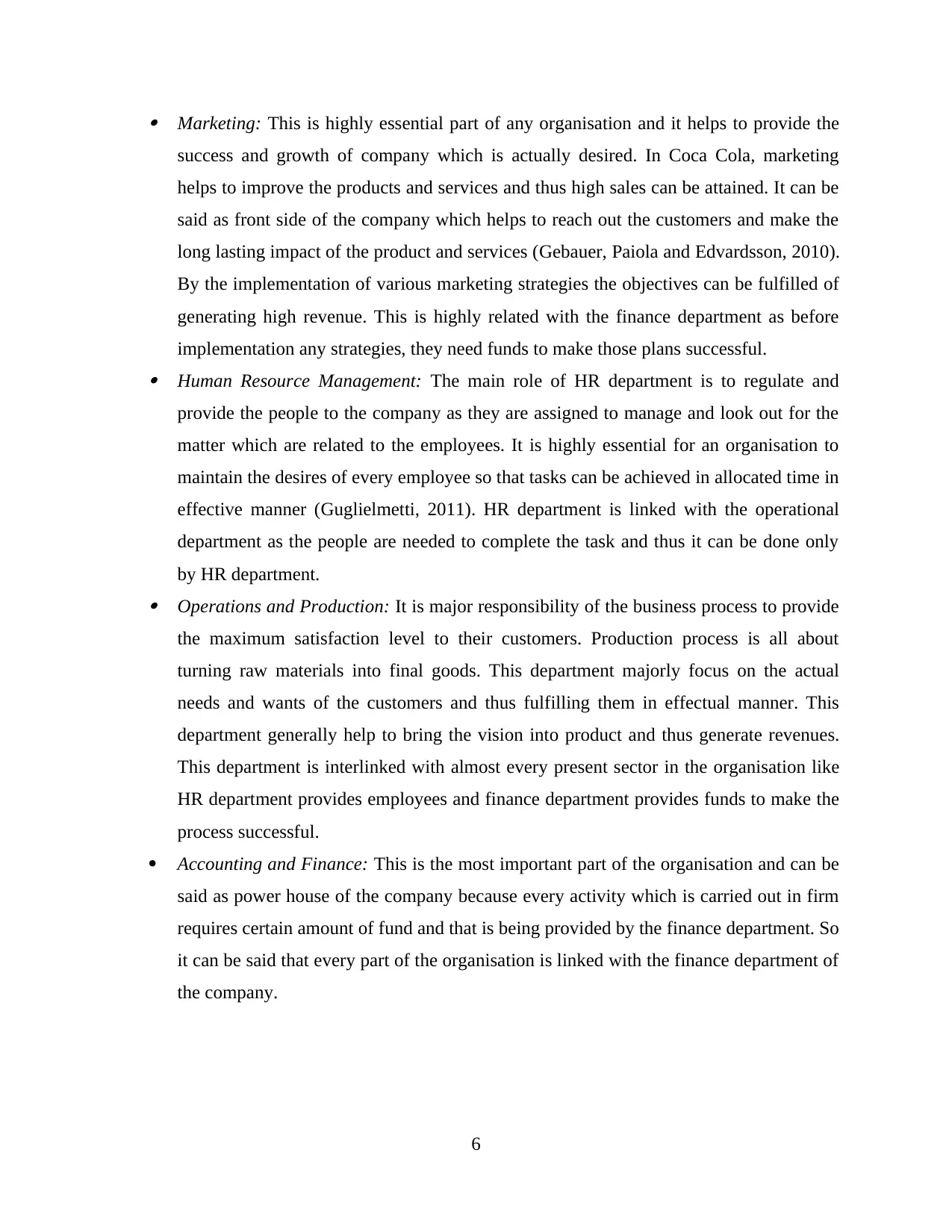
Marketing: This is highly essential part of any organisation and it helps to provide the
success and growth of company which is actually desired. In Coca Cola, marketing
helps to improve the products and services and thus high sales can be attained. It can be
said as front side of the company which helps to reach out the customers and make the
long lasting impact of the product and services (Gebauer, Paiola and Edvardsson, 2010).
By the implementation of various marketing strategies the objectives can be fulfilled of
generating high revenue. This is highly related with the finance department as before
implementation any strategies, they need funds to make those plans successful. Human Resource Management: The main role of HR department is to regulate and
provide the people to the company as they are assigned to manage and look out for the
matter which are related to the employees. It is highly essential for an organisation to
maintain the desires of every employee so that tasks can be achieved in allocated time in
effective manner (Guglielmetti, 2011). HR department is linked with the operational
department as the people are needed to complete the task and thus it can be done only
by HR department. Operations and Production: It is major responsibility of the business process to provide
the maximum satisfaction level to their customers. Production process is all about
turning raw materials into final goods. This department majorly focus on the actual
needs and wants of the customers and thus fulfilling them in effectual manner. This
department generally help to bring the vision into product and thus generate revenues.
This department is interlinked with almost every present sector in the organisation like
HR department provides employees and finance department provides funds to make the
process successful.
Accounting and Finance: This is the most important part of the organisation and can be
said as power house of the company because every activity which is carried out in firm
requires certain amount of fund and that is being provided by the finance department. So
it can be said that every part of the organisation is linked with the finance department of
the company.
6
success and growth of company which is actually desired. In Coca Cola, marketing
helps to improve the products and services and thus high sales can be attained. It can be
said as front side of the company which helps to reach out the customers and make the
long lasting impact of the product and services (Gebauer, Paiola and Edvardsson, 2010).
By the implementation of various marketing strategies the objectives can be fulfilled of
generating high revenue. This is highly related with the finance department as before
implementation any strategies, they need funds to make those plans successful. Human Resource Management: The main role of HR department is to regulate and
provide the people to the company as they are assigned to manage and look out for the
matter which are related to the employees. It is highly essential for an organisation to
maintain the desires of every employee so that tasks can be achieved in allocated time in
effective manner (Guglielmetti, 2011). HR department is linked with the operational
department as the people are needed to complete the task and thus it can be done only
by HR department. Operations and Production: It is major responsibility of the business process to provide
the maximum satisfaction level to their customers. Production process is all about
turning raw materials into final goods. This department majorly focus on the actual
needs and wants of the customers and thus fulfilling them in effectual manner. This
department generally help to bring the vision into product and thus generate revenues.
This department is interlinked with almost every present sector in the organisation like
HR department provides employees and finance department provides funds to make the
process successful.
Accounting and Finance: This is the most important part of the organisation and can be
said as power house of the company because every activity which is carried out in firm
requires certain amount of fund and that is being provided by the finance department. So
it can be said that every part of the organisation is linked with the finance department of
the company.
6
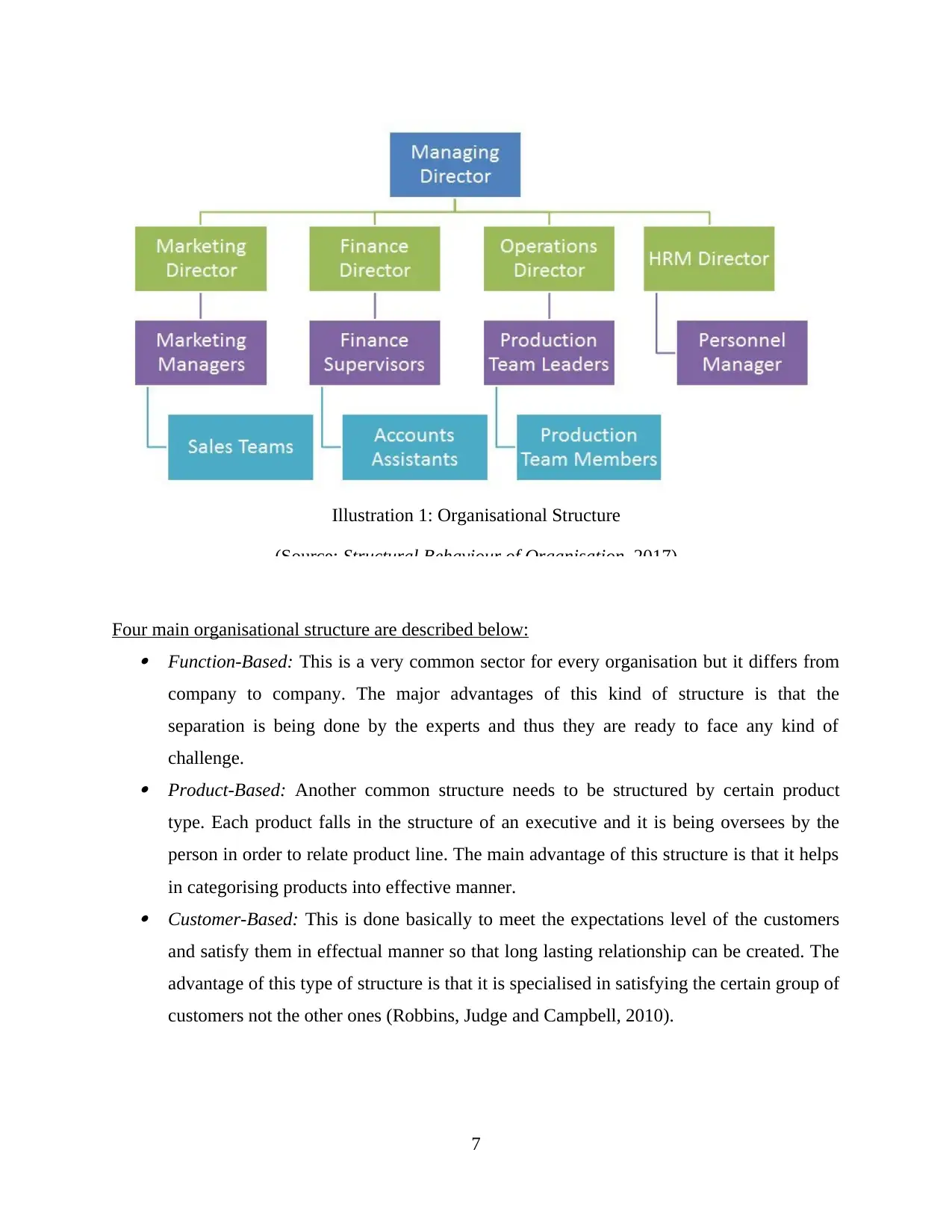
Illustration 1: Organisational Structure
(Source: Structural Behaviour of Organisation, 2017)
Four main organisational structure are described below: Function-Based: This is a very common sector for every organisation but it differs from
company to company. The major advantages of this kind of structure is that the
separation is being done by the experts and thus they are ready to face any kind of
challenge. Product-Based: Another common structure needs to be structured by certain product
type. Each product falls in the structure of an executive and it is being oversees by the
person in order to relate product line. The main advantage of this structure is that it helps
in categorising products into effective manner. Customer-Based: This is done basically to meet the expectations level of the customers
and satisfy them in effectual manner so that long lasting relationship can be created. The
advantage of this type of structure is that it is specialised in satisfying the certain group of
customers not the other ones (Robbins, Judge and Campbell, 2010).
7
(Source: Structural Behaviour of Organisation, 2017)
Four main organisational structure are described below: Function-Based: This is a very common sector for every organisation but it differs from
company to company. The major advantages of this kind of structure is that the
separation is being done by the experts and thus they are ready to face any kind of
challenge. Product-Based: Another common structure needs to be structured by certain product
type. Each product falls in the structure of an executive and it is being oversees by the
person in order to relate product line. The main advantage of this structure is that it helps
in categorising products into effective manner. Customer-Based: This is done basically to meet the expectations level of the customers
and satisfy them in effectual manner so that long lasting relationship can be created. The
advantage of this type of structure is that it is specialised in satisfying the certain group of
customers not the other ones (Robbins, Judge and Campbell, 2010).
7
⊘ This is a preview!⊘
Do you want full access?
Subscribe today to unlock all pages.

Trusted by 1+ million students worldwide
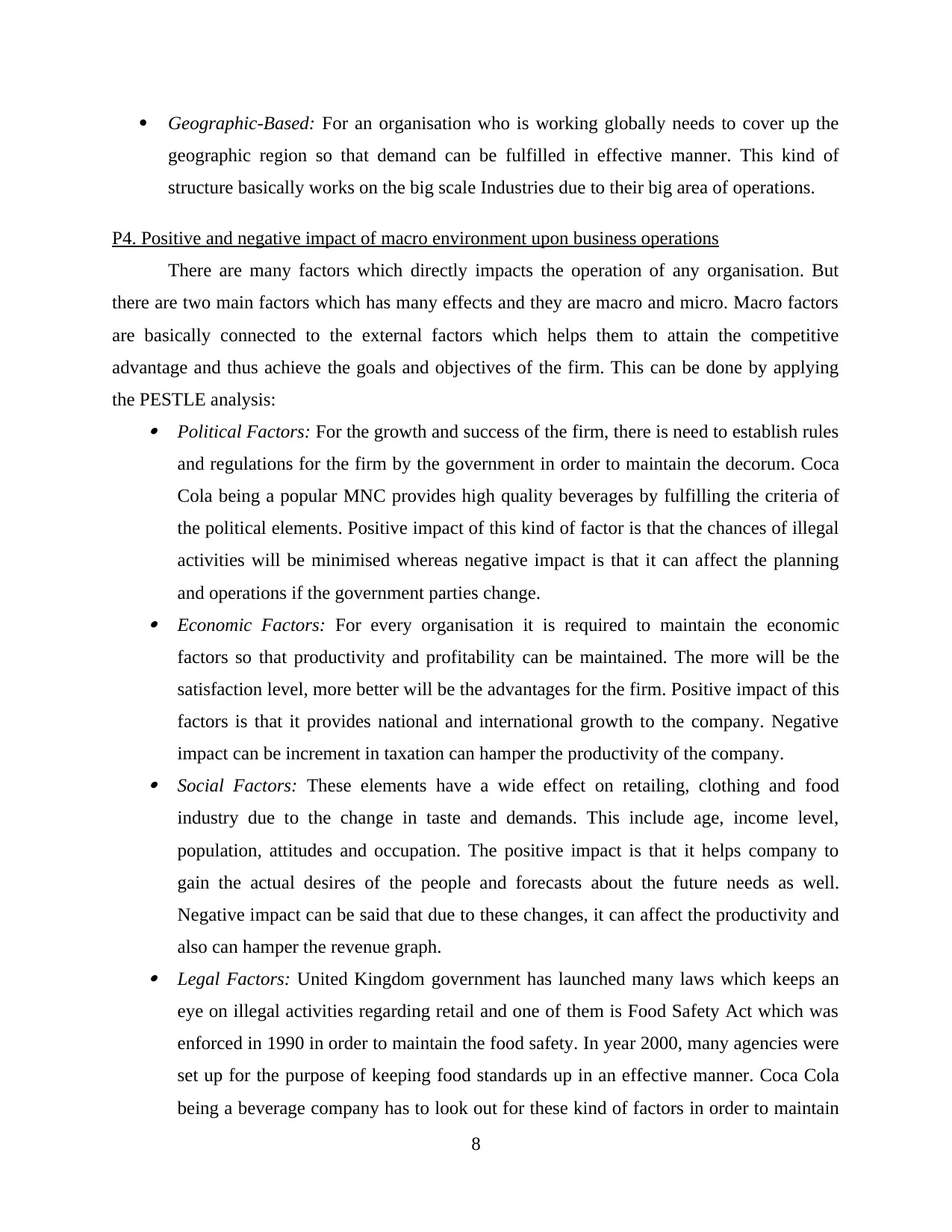
Geographic-Based: For an organisation who is working globally needs to cover up the
geographic region so that demand can be fulfilled in effective manner. This kind of
structure basically works on the big scale Industries due to their big area of operations.
P4. Positive and negative impact of macro environment upon business operations
There are many factors which directly impacts the operation of any organisation. But
there are two main factors which has many effects and they are macro and micro. Macro factors
are basically connected to the external factors which helps them to attain the competitive
advantage and thus achieve the goals and objectives of the firm. This can be done by applying
the PESTLE analysis: Political Factors: For the growth and success of the firm, there is need to establish rules
and regulations for the firm by the government in order to maintain the decorum. Coca
Cola being a popular MNC provides high quality beverages by fulfilling the criteria of
the political elements. Positive impact of this kind of factor is that the chances of illegal
activities will be minimised whereas negative impact is that it can affect the planning
and operations if the government parties change. Economic Factors: For every organisation it is required to maintain the economic
factors so that productivity and profitability can be maintained. The more will be the
satisfaction level, more better will be the advantages for the firm. Positive impact of this
factors is that it provides national and international growth to the company. Negative
impact can be increment in taxation can hamper the productivity of the company. Social Factors: These elements have a wide effect on retailing, clothing and food
industry due to the change in taste and demands. This include age, income level,
population, attitudes and occupation. The positive impact is that it helps company to
gain the actual desires of the people and forecasts about the future needs as well.
Negative impact can be said that due to these changes, it can affect the productivity and
also can hamper the revenue graph. Legal Factors: United Kingdom government has launched many laws which keeps an
eye on illegal activities regarding retail and one of them is Food Safety Act which was
enforced in 1990 in order to maintain the food safety. In year 2000, many agencies were
set up for the purpose of keeping food standards up in an effective manner. Coca Cola
being a beverage company has to look out for these kind of factors in order to maintain
8
geographic region so that demand can be fulfilled in effective manner. This kind of
structure basically works on the big scale Industries due to their big area of operations.
P4. Positive and negative impact of macro environment upon business operations
There are many factors which directly impacts the operation of any organisation. But
there are two main factors which has many effects and they are macro and micro. Macro factors
are basically connected to the external factors which helps them to attain the competitive
advantage and thus achieve the goals and objectives of the firm. This can be done by applying
the PESTLE analysis: Political Factors: For the growth and success of the firm, there is need to establish rules
and regulations for the firm by the government in order to maintain the decorum. Coca
Cola being a popular MNC provides high quality beverages by fulfilling the criteria of
the political elements. Positive impact of this kind of factor is that the chances of illegal
activities will be minimised whereas negative impact is that it can affect the planning
and operations if the government parties change. Economic Factors: For every organisation it is required to maintain the economic
factors so that productivity and profitability can be maintained. The more will be the
satisfaction level, more better will be the advantages for the firm. Positive impact of this
factors is that it provides national and international growth to the company. Negative
impact can be increment in taxation can hamper the productivity of the company. Social Factors: These elements have a wide effect on retailing, clothing and food
industry due to the change in taste and demands. This include age, income level,
population, attitudes and occupation. The positive impact is that it helps company to
gain the actual desires of the people and forecasts about the future needs as well.
Negative impact can be said that due to these changes, it can affect the productivity and
also can hamper the revenue graph. Legal Factors: United Kingdom government has launched many laws which keeps an
eye on illegal activities regarding retail and one of them is Food Safety Act which was
enforced in 1990 in order to maintain the food safety. In year 2000, many agencies were
set up for the purpose of keeping food standards up in an effective manner. Coca Cola
being a beverage company has to look out for these kind of factors in order to maintain
8
Paraphrase This Document
Need a fresh take? Get an instant paraphrase of this document with our AI Paraphraser
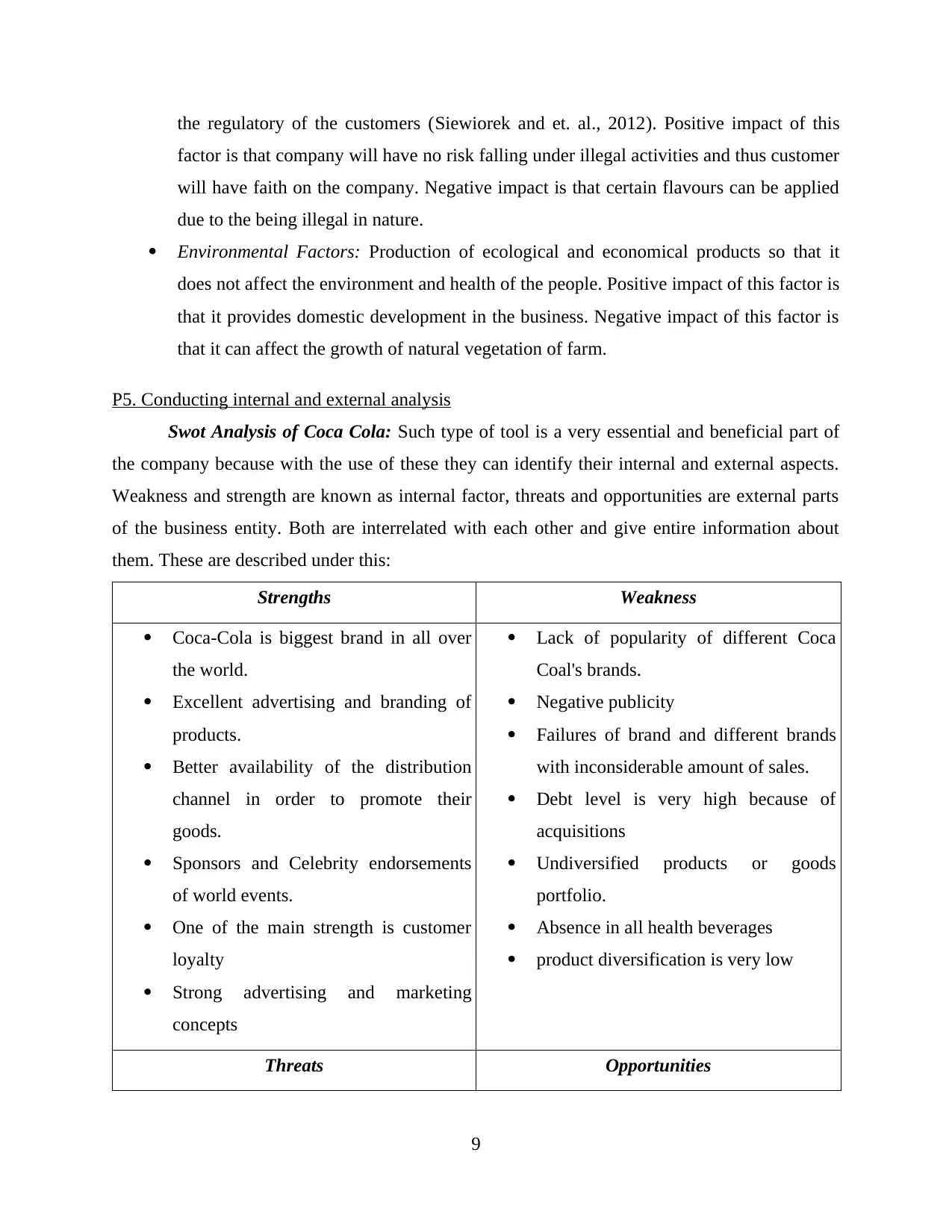
the regulatory of the customers (Siewiorek and et. al., 2012). Positive impact of this
factor is that company will have no risk falling under illegal activities and thus customer
will have faith on the company. Negative impact is that certain flavours can be applied
due to the being illegal in nature.
Environmental Factors: Production of ecological and economical products so that it
does not affect the environment and health of the people. Positive impact of this factor is
that it provides domestic development in the business. Negative impact of this factor is
that it can affect the growth of natural vegetation of farm.
P5. Conducting internal and external analysis
Swot Analysis of Coca Cola: Such type of tool is a very essential and beneficial part of
the company because with the use of these they can identify their internal and external aspects.
Weakness and strength are known as internal factor, threats and opportunities are external parts
of the business entity. Both are interrelated with each other and give entire information about
them. These are described under this:
Strengths Weakness
Coca-Cola is biggest brand in all over
the world.
Excellent advertising and branding of
products.
Better availability of the distribution
channel in order to promote their
goods.
Sponsors and Celebrity endorsements
of world events.
One of the main strength is customer
loyalty
Strong advertising and marketing
concepts
Lack of popularity of different Coca
Coal's brands.
Negative publicity
Failures of brand and different brands
with inconsiderable amount of sales.
Debt level is very high because of
acquisitions
Undiversified products or goods
portfolio.
Absence in all health beverages
product diversification is very low
Threats Opportunities
9
factor is that company will have no risk falling under illegal activities and thus customer
will have faith on the company. Negative impact is that certain flavours can be applied
due to the being illegal in nature.
Environmental Factors: Production of ecological and economical products so that it
does not affect the environment and health of the people. Positive impact of this factor is
that it provides domestic development in the business. Negative impact of this factor is
that it can affect the growth of natural vegetation of farm.
P5. Conducting internal and external analysis
Swot Analysis of Coca Cola: Such type of tool is a very essential and beneficial part of
the company because with the use of these they can identify their internal and external aspects.
Weakness and strength are known as internal factor, threats and opportunities are external parts
of the business entity. Both are interrelated with each other and give entire information about
them. These are described under this:
Strengths Weakness
Coca-Cola is biggest brand in all over
the world.
Excellent advertising and branding of
products.
Better availability of the distribution
channel in order to promote their
goods.
Sponsors and Celebrity endorsements
of world events.
One of the main strength is customer
loyalty
Strong advertising and marketing
concepts
Lack of popularity of different Coca
Coal's brands.
Negative publicity
Failures of brand and different brands
with inconsiderable amount of sales.
Debt level is very high because of
acquisitions
Undiversified products or goods
portfolio.
Absence in all health beverages
product diversification is very low
Threats Opportunities
9
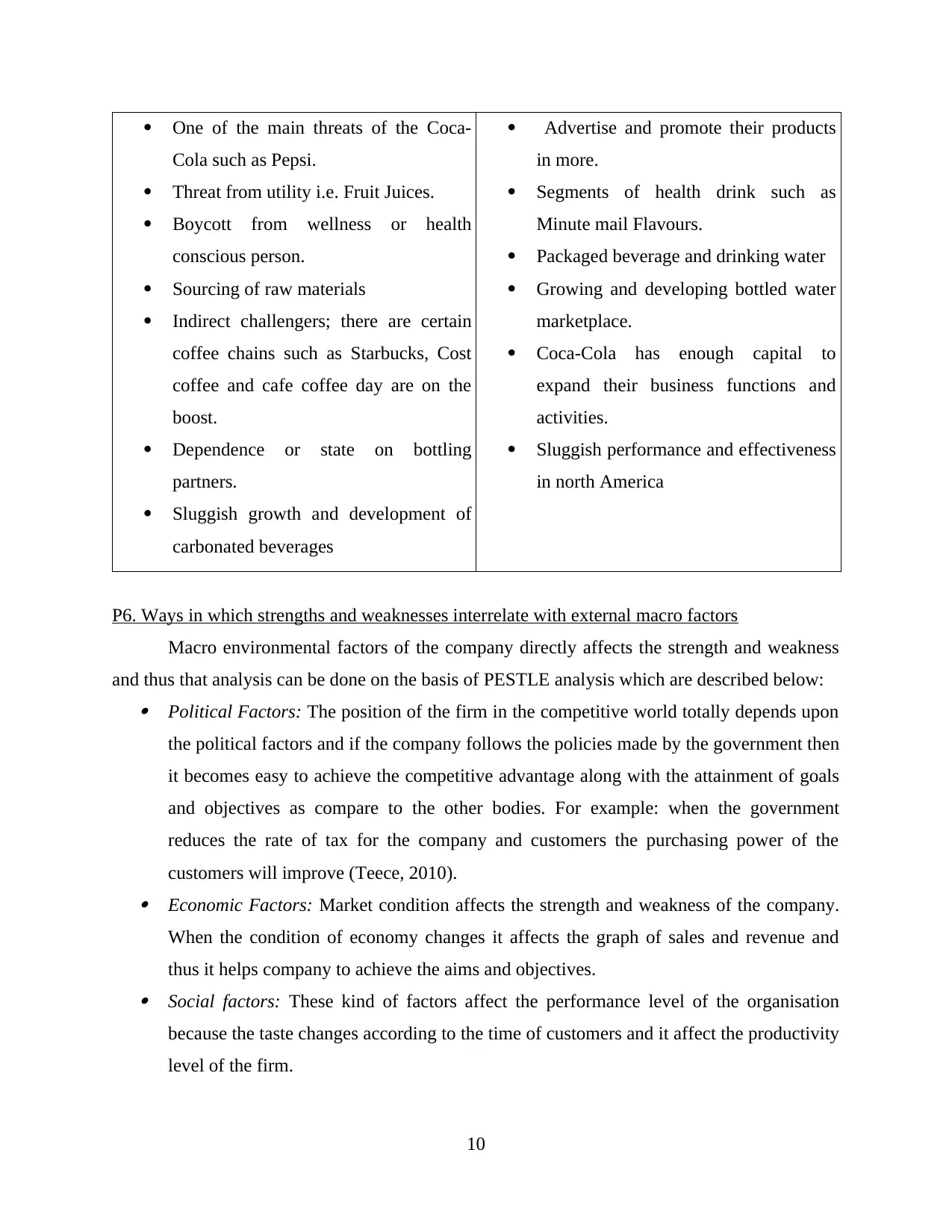
One of the main threats of the Coca-
Cola such as Pepsi.
Threat from utility i.e. Fruit Juices.
Boycott from wellness or health
conscious person.
Sourcing of raw materials
Indirect challengers; there are certain
coffee chains such as Starbucks, Cost
coffee and cafe coffee day are on the
boost.
Dependence or state on bottling
partners.
Sluggish growth and development of
carbonated beverages
Advertise and promote their products
in more.
Segments of health drink such as
Minute mail Flavours.
Packaged beverage and drinking water
Growing and developing bottled water
marketplace.
Coca-Cola has enough capital to
expand their business functions and
activities.
Sluggish performance and effectiveness
in north America
P6. Ways in which strengths and weaknesses interrelate with external macro factors
Macro environmental factors of the company directly affects the strength and weakness
and thus that analysis can be done on the basis of PESTLE analysis which are described below: Political Factors: The position of the firm in the competitive world totally depends upon
the political factors and if the company follows the policies made by the government then
it becomes easy to achieve the competitive advantage along with the attainment of goals
and objectives as compare to the other bodies. For example: when the government
reduces the rate of tax for the company and customers the purchasing power of the
customers will improve (Teece, 2010). Economic Factors: Market condition affects the strength and weakness of the company.
When the condition of economy changes it affects the graph of sales and revenue and
thus it helps company to achieve the aims and objectives. Social factors: These kind of factors affect the performance level of the organisation
because the taste changes according to the time of customers and it affect the productivity
level of the firm.
10
Cola such as Pepsi.
Threat from utility i.e. Fruit Juices.
Boycott from wellness or health
conscious person.
Sourcing of raw materials
Indirect challengers; there are certain
coffee chains such as Starbucks, Cost
coffee and cafe coffee day are on the
boost.
Dependence or state on bottling
partners.
Sluggish growth and development of
carbonated beverages
Advertise and promote their products
in more.
Segments of health drink such as
Minute mail Flavours.
Packaged beverage and drinking water
Growing and developing bottled water
marketplace.
Coca-Cola has enough capital to
expand their business functions and
activities.
Sluggish performance and effectiveness
in north America
P6. Ways in which strengths and weaknesses interrelate with external macro factors
Macro environmental factors of the company directly affects the strength and weakness
and thus that analysis can be done on the basis of PESTLE analysis which are described below: Political Factors: The position of the firm in the competitive world totally depends upon
the political factors and if the company follows the policies made by the government then
it becomes easy to achieve the competitive advantage along with the attainment of goals
and objectives as compare to the other bodies. For example: when the government
reduces the rate of tax for the company and customers the purchasing power of the
customers will improve (Teece, 2010). Economic Factors: Market condition affects the strength and weakness of the company.
When the condition of economy changes it affects the graph of sales and revenue and
thus it helps company to achieve the aims and objectives. Social factors: These kind of factors affect the performance level of the organisation
because the taste changes according to the time of customers and it affect the productivity
level of the firm.
10
⊘ This is a preview!⊘
Do you want full access?
Subscribe today to unlock all pages.

Trusted by 1+ million students worldwide
1 out of 15
Related Documents
Your All-in-One AI-Powered Toolkit for Academic Success.
+13062052269
info@desklib.com
Available 24*7 on WhatsApp / Email
![[object Object]](/_next/static/media/star-bottom.7253800d.svg)
Unlock your academic potential
Copyright © 2020–2025 A2Z Services. All Rights Reserved. Developed and managed by ZUCOL.





